Beaver (Castor canadiensis)
Ontario Canada
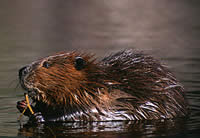 Beaver ,
semiaquatic mammal of the family Castoridae in the rodent order,
noted for the building of dams. The family contains a single genus,
Castor, with two species: C. canadensis, found in the New World
(North America), and C. fiber, found in the Old World (Europe).
Beaver ,
semiaquatic mammal of the family Castoridae in the rodent order,
noted for the building of dams. The family contains a single genus,
Castor, with two species: C. canadensis, found in the New World
(North America), and C. fiber, found in the Old World (Europe).
The two species differ chiefly in the shape of the nasal bones and
are so much alike that some
authorities consider them to be varieties of the same species.
Beaver viewing is best in October when they are repairing their dams and laying in their winter food supplies and active during the day. In the summer beaver are seldom seen during the day, beaver are nocturnal, and best viewing is the evening. Many beaver can be viewed from the roadside carrying on their activities, just about any low lying wet are or weedy lake has them.
Appearance
The beaver is usually about 63 - 76 cm (about
25 - 30 in) long.
It stands less than 30 cm (12 in) high, rich brown in color; and
the broad, flat, scaly tail shaped like a paddle, is about 15cm
(6in) wide and 25 - 35 cm (about 9-10 in) long.
They are large rodents; weighing 13 - 34kg.
(30-75lbs) with the average adult beaver weighing about 16 kg (about
35 lb), but specimens as heavy as 40 kg (90 LB) have been found,
and some extinct beavers were almost bear-like in size.
The fur is usually reddish-brown above and lighter or grayish below.
The body is plump, the back arched, the neck thick, dense waterproof
fur, and subcutaneous layer of fat minimize heat loss to icy water.
Adaptations of the respiratory and circulatory systems increase
their efficiency. Large, hind webbed feet and powerful hind legs
further enhance its underwater abilities, five digits and all are
clawed, 2nd claw double.
The eyes are small and the nostrils closeable A transparent eyelid protects the eyes, and the ear and nose openings can be closed while the animal is underwater.
The skull is massive , with marked ridges for fixing the muscles that work the jaws and has has 20 teeth, there are 4 mammae.
Huge front teeth on either jaw are like
those of other rodents, wearing away more
rapidly behind so as to leave a sharp, enameled chisel edge.
With these the beaver can cut down large trees.
Habitat
The life of the colony is centered on the lodge and pond. Streams and lakes with trees or alders on banks. Occur along rivers and drainage canals, beavers may give up houses in favor of bank burrows which they dig.
Widespread throughout Northwestern Ontario, in ponds, lakes and slow-moving rivers and creeks beside forested areas.
A stick-and-mud dam across a stream, or a large conical house of similar material at the edge of a lake and stumps of small trees in the vicinity showing tooth marks will reveal the presence of the Beaver .
Chiefly nocturnal, occasionally seen by day; appears shortly after sundown. Family groups of parents, yearlings, and kits may occupy a burrow in bank or den along swift streams. Colony defends territory against other colonies. Beavers have a pair of anal scent glands, called castors, that secrete a musklike substance called castoreum, probably for marking territories.
Has been known to move up to 240km (150mi.) from birthplace, average under 9.6km (6mi).
Beaver Colony
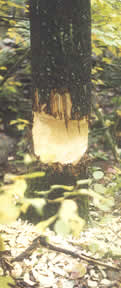 The
social unit in beaver life, is known as a colony, consists of four
to eight related individuals, dominated by an adult female, although
in some cases a male may be dominant. Evidence suggests that the
dominant male and female animal in a colony form a monogamous pair
and may live 20 years or more.
The
social unit in beaver life, is known as a colony, consists of four
to eight related individuals, dominated by an adult female, although
in some cases a male may be dominant. Evidence suggests that the
dominant male and female animal in a colony form a monogamous pair
and may live 20 years or more.
The beaver is an active animal and appears to be constantly busy, whether building a dam or a lodge, or gathering a food cache to feed it through the winter. One of the few animals, besides man, are capable of altering its environment as much as the beaver. In its quest to create and maintain a suitable habitat, the beaver creates wetlands which become breeding and feeding habitats of waterfowl, fish and other water-dependent mammals, builds dams of sticks and mud across streams and slow rivers, large cone-shaped lodges, either in deep water or near the bank.
The Pond - itself has profound ecological effects on the surrounding habitat. The flooding causes the deaths of some trees. The dead trees in turn, provide e shelter for various birds that otherwise would not inhabit the place. Water-loving plants thrive in and around the pond, and these provide food and shelter for a variety of animals. The retention of water in the pond causes the local water table to rise, enhancing the growth of additional vegetation. The pond and surrounding wet area acts as a reservoir, preventing rapid runoff of water during rains and ensuing that the stream flows steadily throughout the year. The predictable stream flow allows trout to survive, and further downstream, it allows humans to plan agricultural activities.
Although the beaver is a powerful swimmer, it has difficulty dragging over the ground the logs and branches it needs for building and for food. It usually selects trees 5 to 20 cm (2 to 8 in) in diameter, but it can fell trees with diameters as large as 76 cm (30 in). Colonies of beavers therefore often dig canals from the pond to a grove of trees. Such canals are up to 1 m (3 ft) wide and deep and often a few hundred meters long. The timber is then readily floated down the canal toward the pond.
The Beaver ponds eventually fills with sediment and it becomes less useful to the beavers, and eventually the colony may abandon the site and move further up or down stream. The abandoned pond gradually becomes covered with meadow grasses, and the resulting lush open area is productive of protein-rich grasses for cattle and horses.
The Lodge - Beavers are social animals.
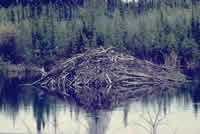 In
areas where food is abundant and the locality secluded, the number
of families in a beaver community is rather large. The so-called
beaver lodge is a unique structure.
In
areas where food is abundant and the locality secluded, the number
of families in a beaver community is rather large. The so-called
beaver lodge is a unique structure.
The lodge itself is an oven-shaped house of sticks, grass, and moss, woven together and plastered with mud, increasing gradually in size with year after year of repair and elaboration. The room inside may measure 2.4 m (8 ft) wide and up to 1 m (3 ft) high. The floor is carpeted with bark, grass, and wood chips, sometimes with special storerooms adjoining.
Three distinct kinds exist, their differences depending on whether they are built on islands, on the banks of ponds, or on the shores of lakes.
The island lodge consists of a central chamber, with its floor a little above the level of the water, and with two entrances. One of these, the wood entrance, is a straight incline rising from the water, opening into the floor of the hut. The other approach, the beaver entrance, is more abrupt in its descent to the water.
The pond lodge is built either a short way back from the edge of the bank, or partly hanging over it, with the front wall built up from the bottom of the pond.
The lake lodge is built on the shelving shores of lakes.
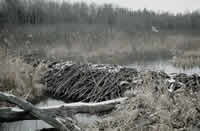 The
Dam - The dams used by beavers to widen the area and increase
the depth of water around their homes are constructed either of
sticks and poles or more firmly and solidly of mud, brushwood, and
stones. Beaver dams also help control runoff.
The
Dam - The dams used by beavers to widen the area and increase
the depth of water around their homes are constructed either of
sticks and poles or more firmly and solidly of mud, brushwood, and
stones. Beaver dams also help control runoff.
As time goes by the beaver repairs and adds
to the dam. Floating material lodges there, and vegetation growing
on the top adds its roots to the strength of the dam. Frequently
the beaver builds a smaller dam downstream in order to back up some
water against the original dam and thus decrease the pressure of
water on it from the other side.
The dams are about 1.5 m (about 5 ft) high, usually more than 3
m (10 ft) wide at the base, and narrow at the top.
Diet
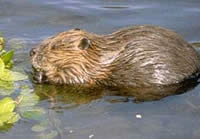 Beavers
are exclusively Herbivore (vegetarian in diet); the beaver will
eat non-woody vegetation in the summer (leaves, buds, water vegetation
and underwater roots); in winter, it will eat woody vegetation (mainly
bark of trees and shrubs) it has stored in an underwater cache near
its lodge.
Beavers
are exclusively Herbivore (vegetarian in diet); the beaver will
eat non-woody vegetation in the summer (leaves, buds, water vegetation
and underwater roots); in winter, it will eat woody vegetation (mainly
bark of trees and shrubs) it has stored in an underwater cache near
its lodge.
Preferred food is aspen, poplar, birch, maple, willow, and alder; feeds on bark and small twigs; stores branches and small sections of logs underwater near lodge. A favorite food item is the cambial, or growing, layer of tissue just under the bark of shrubs and trees. Many of the trees that are cut are stripped of bark on the spot, or carried to the pond for storage under water as a winter food cache.
Buds and roots are also consumed, and when they are needed, a variety of plant species are accepted. There are definite preferences, however, and aspen and willow are high on the beaver's list of favorites. The animals may travel some distance from water to secure food. When a rich food source is exploited, canals may be dug from the pond to the pasture to facilitate the transportation of the items to the beavers homes.
Much of the food ingested by a beaver consists of cellulose, which is normally indigestible by mammals. However, these animals have colonies of microorganisms living in the cecum, a pouch between the large and small intestine, and these symbionts digest up to 30 percent of the cellulose that the beaver consumes. An additional recycling of plant food occurs when certain fecal pellets are eaten and run through the digestive process a second time.
Reproductive Characteristics
- sexually mature 2 - 2 1/2 years
- gestation of about 107 - 128 days
- 1 litter a year
- Born between April-July
- 2-4 offspring, occasionally 8 young , known as kits,
The kits are born fully furred with the eyes partially open, and the incisor teeth erupted. Accounts as to duration of dependency on the mother suggest a period of six weeks to three months.
The animals may continue to grow for several years; they become sexually mature in their second year. There is some evidence that the presence of a mature female in a colony inhibits sexual maturity in younger females in the group. Much evidence suggests that the dominant male and female animal in a colony form a monogamous pair and may live 20 years or more.
Predators
In the water, the beaver is usually safe from predators, However, on land it is awkward and often falls prey to wolves, coyotes, red fox, black bears, lynx, bobcats, fishers and even domestic dogs.
A loud report, caused by the tail as the Beaver dives below the surface of the water, will also indicate its presence and warning to other beavers of danger.
Beavers and Humans - Beavers have
long been exploited for their fur, and for many years
during the 18th and 19th centuries hundreds of thousands of beaver
skins were exported to
Europe from North America annually. The animals were also sometimes
destroyed because it will come into conflict with man by cutting
valuable trees and creating floodlands by plugging culverts. Ceaseless
slaughter led to near extinction of beavers in both Europe and North
America. The beaver is still almost extinct in Europe, but is becoming
reestablished in Canada and in protected areas of the United States.
An important fur animal and water conservationist; timber destroyed
is mostly low-grade; occasionally floods roads or fields; meat edible.
Once extensively trapped for their fur, the beaver has managed to
survive in large numbers.
Lifespan
Lives 11 years in wild, 20 years in captivity
Tracks
Signs of beaver activity include, dams, lodges, stumps of felled trees with gnawed marks. Beavers also make scent mounds marked with catoreum, a strong smelling yellowish fluid.
Beaver tracks often become hidden by its tail or trees and branches it drags. If you see tracks look for webbing and broad toenails on hind prints, often inner second toenail does not show. The track may be irregular alternating sequence often with double register. Beavers have 5 toes on each foot rarely will all register. Beavers usually use the same which will become well worn trail.
Prints
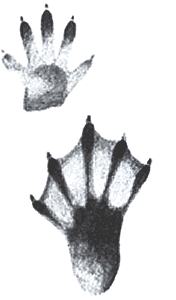 |
 |
Fore and Hind |
Walking |
Fore Print
Length:6.4-10 cm (2.5 - 4.0 in )
Width: 5.1 - 8.9 cm (2.0 - 3.5 in )
Hind Print
Length:13-18 cm (5.0 - 7.0 in )
Width: 8.4 - 13 cm (3.3 - 5.3 in )
Straddle
15 - 28 cm (6.0 - 11 in)
Stride
Walking: 7.6 - 17 cm (3.0 - 6.5 in)
Size
Length with tail: 91 - 120 cm (3.0 - 3.9 ft)
Weight
13 - 34kg. (30-75lbs)
History - Canada's Official Emblem The Beaver
The quest for religious and political freedom
is often cited as the reasons Europeans colonized North America.
But natural resources were another major draw. These included whales,
vast schools of cod and towering pines. But the resource that lured
explorers across the continent was the beaver.
In the late 1600s and early 1700s, the demand for beaver fur was
driven largely by the demand for fur hats in Europe. The French
and British led the charge, dispatching explorers deep into the
North American wilderness to trap and trade for furs with Native
Americans.
The first North American coat of arms to depict a beaver was created
by Sir William Alexander, who was granted title to Nova Scotia in
1621. In 1678, the Hudson’s Bay Company created a coat of arms
with a shield depicting four beavers separated by a red St. George’s
Cross. A coin was even created to equal the value of one beaver
pelt.
Hudson’s Bay Company was no ordinary business playing a major
role in the exploration of Canada, even helping determine its borders.
A potent rival to Hudson’s Bay Company, the French also honored
the beaver in 1678. In that year, Louis de Buade de Frontenac, then
Governor of New France, suggested the beaver as a suitable emblem
for the colony, and proposed it be included in the armorial bearings
of Quebec City. In 1690, the “Kebeca Liberata Medal” was
struck to commemorate France’s successful defense of Quebec.
The reverse depicts a seated woman, representing France, with a
beaver at her feet, representing Canada.
The beaver was included in the City of Montréal’s coat
of arms when it was incorporated as a city in 1833. The beaver was
on the verge of becoming a symbol representing all of Canada.
Sir Sandford Fleming featured the beaver on the first Canadian postage
stamp—the “Three Penny Beaver” of 1851. The beaver
appeared with the other popular Canadian symbol, the maple leaf,
on the masthead of Le Canadien, a newspaper published in Lower Canada.
It was one of the emblems of the Société Saint-Jean-Baptiste
for a time, and it’s still found on the crest of the Canadian
Pacific Railway Company.
The mid-19th century marked a turning point. Canada was home to
an estimated six million beavers before the fur trade began. With
100,000 pelts being shipped to Europe each year during the peak
of the fur trade, the valuable rodent was pushed to the edge of
extinction.
Canada’s beavers were saved by silk hats, which Europeans fell
in love with about the mid-19th century. Beaver populations began
to recover as Great Britain’s northern North American territories
evolved towards nationhood.
On March 24, 1975, the beaver received the highest honor ever bestowed
on a rodent. On that day it became an official emblem of Earth’s
second largest nation when an “act to provide for the recognition
of the beaver (castor canadensis) as a symbol of the sovereignty
of Canada” received royal assent. It basically became Canada’s
national animal, just as the bald eagle had basically become the
United States’ national bird earlier. And after the Soviet
Union collapsed, the beaver ruled over the largest nation!
Today, you can see the Canadian beaver on the back of Canadian nickels
and on coats of arms representing several of Canada’s provinces.
On provincial coats of arms, the beaver generally represents Canada,
or national unity, just as a bald eagle graces some state seals
as a symbol of unity. Some provincial coats of arms also depict
a lion as a symbol of Great Britain.
One group of Canadians have celebrated National
Beaver Day on the last Friday in February since 1974. They are
the Nova Scotia Association of Architects, a club of builders any
beaver could appreciate.
